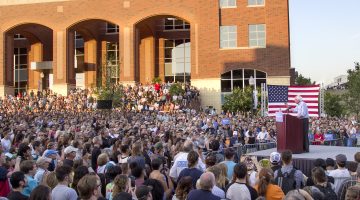Staff Editorial
The 2016 presidential election cycle has seen the rise of many contentious issues that have revealed the deep ideological divide afflicting American politics. Immigration is one such issue, and has drawn various responses and potential solutions, from paths to citizenship to the construction of a giant wall along the border.
The first Democratic debate of the election cycle is yet another reminder that immigration is a key issue; however, its prominent position in the debate is nothing more than a carefully crafted strategy for reaching out to Latino voters. According to the Las Vegas Review-Journal, the candidates will focus on immigration because “there is a large Latino population” in Las Vegas, where the debate is being held.
While immigration is indeed a complex and far-reaching problem that must be addressed, the use of immigration policy as an attempt to pander to Latino voters needs to stop. It is high time politicians recognize that the Latino population is as diverse as it is large, and it cannot and should not be pigeonholed as a single-issue constituency.
The Latino population in the United States is the largest it has ever been. According to the Pew Research Center, the number of Latinos in the U.S. reached 55.4 million in 2014, up 1.2 million from 2013. In addition, Pew states that the number of registered Latino voters is the highest it’s ever been, with 25.2 million in 2014, “or 11 percent of the overall U.S. voter population.”
Given these numbers it is no wonder that many presidential candidates are trying to win the “Latino vote.” But is there even such a thing as the Latino vote?
The Latino population is incredibly diverse. Latino is a panethnic term that includes families and individuals with origins throughout Central and South America, as well as the U.S. and the Caribbean. It includes individuals whose families have immigrated to this country with and without legal documentation, one year or five generations ago. It includes individuals who speak only Spanish, who are bilingual as well as those who speak only English. It includes DREAMers who protest for their right to an education and the members of la raza who have spent decades asserting their cultural legitimacy throughout Atzlán.
The diversity of people we classify under a broad term makes it difficult, almost impossible, to unify their varied social and political interests into a single platform addressing a single issue. Doing so not only disparages the cultural differences among Latinos but also serves to alienate the 64.4 percent of Latinos the Census Bureau reports are native citizens as of 2012.
Focusing on immigration reform as a way to win over Latino voters also presents a larger problem:― non-Latino politicians effectively deciding what matters to Latino voters.
These candidates need to recognize that it is not up to them to decide the most important issues for Latino voters. While it is true that 35.6 percent of Latinos in the U.S. are foreign- born according to Census data, they by no means account for the entire population. Rather than ascribing to insulting stereotypes of Latino-as-immigrant, those who wish to lead our nation should focus their attention on why Latinos remain one of the least politically active ethnic groups in the country.
According to a study by Shanna Pearson-Merkowitz published in the journal American Politics Research, less than 50 percent of Latinos reported voting in the 2008 presidential election. In the same election, 65 percent of African-Americans and 67 percent of whites reported voting. Yet, according to the nonprofit research and advocacy group The Sentencing Project, Latino males are nearly four times as like to go to prison as white males and Latinas are incarcerated at twice the rate of white women.
This demographic information presents a troubling portrait of Latinos’ position in American society -one that reaches beyond a broken immigration system.
If politicians truly want Latinos to vote for them, they should start by addressing the circumstances that prevent individuals from many groups from going to the polls.
A vast array of political research strongly suggests that the more educated and wealthy an individual is, the more likely they are to be politically engaged. Given this research, it is little surprise that Latinos vote at such low rates.
According to the Pew Research Center, 62.4 percent of Latinos have attained a high school education, at most. This could be largely due to the fact that 74 percent of 16- to 25-year-old Latinos surveyed by Pew reported that they “cut their education short during or right after high school … because they had to support their family.” Latinos’ education suffers because of the racial wealth gaps that currently plague this country, with 2014 numbers gathered by Pew stating that the average wealth of white households is “more than 10 times the wealth of Latino households.”
The research does not lie; the Latino population is one at a distinct disadvantage in terms of education and income. Ignoring this information and shoving all Latinos into a stereotyped category is not only a disgraceful insult, it is also perpetuating the inequalities that make it more difficult for any group to achieve educational and socioeconomic advancement.
If politicians truly want to earn the votes of Latinos, they need to stop assuming they know what’s best for a population of over 55 million diverse individuals and start paying attention to the circumstances these individuals often find themselves in.
Politicians are right in that the “Latino vote” should not and cannot be ignored, but they are doing a disservice to their office and constituency in their ignorance. It’s time that they step out of their bubble of privilege and use their influence to effect meaningful change for a group of people whose interests have been all but nonexistent in the national dialogue.
The Nevada Sagebrush editorial board can be reached at tbynum@sagebrush.unr.edu, and on Twitter @TheSagebrush.












